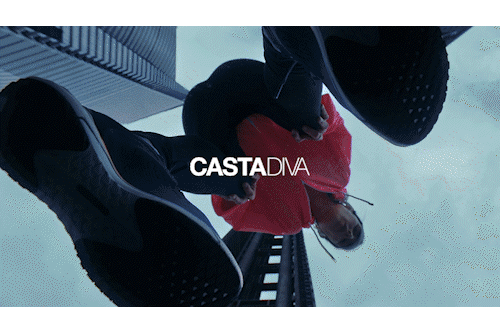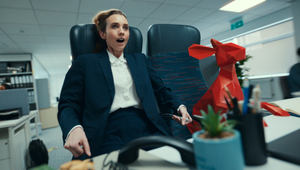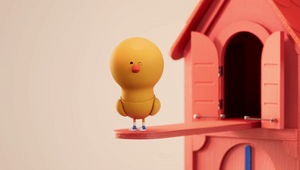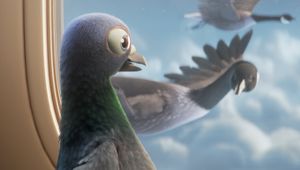
Uprising: Distilling Ideas to the Most Immediate and Satisfying Form with Laurie Rowan

It’s no surprise that Laurie Rowan strives for a high standard of execution and originality within his work, especially since his introduction to animation began at age seven when he ‘started making digital artwork’. With inspiration always around him in the form of both of his parents and the beauty of the Welsh landscape, Laurie focuses on the real, raw emotions of his animated characters.
Had Laurie’s childhood-self known what his career would look like, he would have been very excited by the prospect as he described himself back then as being ‘shy and generally worried’. His obsessions were comics, animation, computer game graphics and watching animated TV which he says gave him an introduction into thinking about the craft behind it: “I think I assumed cartoons were naturally occurring like some kind of sediment or at the very least weren’t attainable.” As a result, Laurie found himself focused on what he did deem as attainable - drawing things, comic collecting and admiring computer game art, despite not owning a console.
Growing up in North Wales, Laurie’s household was certainly a creative one. “My mum is a painter and my dad has a keen interest in music and literature. I spent a lot of my time sitting up trees listening to Alanis Morissette or following my cat around,” he says. These formative years in a quarry village, on the edge of a mountain, is where Laurie was shaped for life as an adult: “It must have affected my outlook; isolation puts an emphasis on individualism and folk-tradition is ubiquitous in Welsh life, all of which leads to a lot of daydreaming about dance and elaborate costumes.”
While embracing his individualism and tinkering around with his dad’s Macbook, Laurie discovered the key to unlocking a world of digital artwork. “It was life changing when I realised you could make artwork with a computer. I spent most of my time animating little vignettes to show friends, writing stories and making music. Little has changed, I’ve just got taller.”
Embarking on a Media Practice and Theory degree at Sussex University was the longest break from producing artwork and animations that Laurie ever had. While the course did have a general production focus, he couldn’t ignore the feeling that was bubbling up inside, encouraging him to go back to his passion: “If anything it was a case of absence makes the heart grow fonder in regards to animation. I tried to ignore it, but it came back.”

During university, Laurie found himself with summer jobs, commentating on a dolphin-based racing game on the Brighton Pier and he continued with this after he finished his degree. He also tried his hand at other jobs, “I worked in a call centre for a few months, and I’m thoroughly glad I did. I found the experience so oppressive, with our time management logged down to the minute and a constant stream of short term incentives designed to distract you from building a life. It put a fire under me to do something I was passionate about, and urgently make an assessment of what that was.” That’s when he found himself back where he belonged. “My first career job was as part of a small animation team in Brighton. They were new and feeling their way, as was I, for better or worse.”
Getting into the industry was always a deliberate choice for Laurie, since his ambition to be a digital artist began at age seven and never relented. This determination to be an animator is what got Laurie his first job, though the means by which he did it were rather unconventional. “I wrote down all the requirements of an entry level animation job, then put together a website where I tried to demonstrate them all on the landing page. It was elaborate, it had a bendy train chugging through Victorian skyscrapers and cliff faces, with the site menu emerging from the briefcase of an alighting passenger,” he says. And it worked, catching the attention of someone who was willing to give him a shot.
Laurie’s first industry project was animating a mobile phone adaptation of a British sci-fi sitcom. In the age of limited internet capabilities, he describes the process: “We had a DVD boxset of the original series and would be given timecodes that picked out individual jokes that would survive outside of the context of the rest of the episode. We’d extract the audio then reanimate the scene with some elaboration.” As a first job, Laurie found the experience invaluable: “It was a very formative process, learning by repetition, studying and mimicking individual character performances. It was a project that took me from being able to animate convincing generic movements, to animating discernible individuals.”
With such a lifelong passion, it’s no surprise that Laurie isn’t short of the fire it takes to continually learn on the job, practice and try things in abundance. He says, “Experimentation and problem solving, learning new skills on a case by case basis. To be pedantic, I can’t frame that question in the past tense, I don’t think my craft will ever be honed.” And Laurie shares his most valuable industry lesson: “To search for answers and to listen. To uncouple your ego from your work and be receptive to input. They’ve been hard learned lessons and thankfully I had patient people around me who allowed me to grow.”
As Laurie continues to work on projects, he describes the piece that he felt shaped and challenged him. The project he embarked on had to deliver on a very specific client brief and vision. He says, “Working with Modern Toss was very formative. Up until that point I only valued a maximalist approach to animation, trying to mimic realistic performance. The guys behind Modern Toss were the first clients I had who had a very specific artistic vision based around restraint and heavily intentional shambolic aesthetic.” And this was a process that required time, patience and the ability to recognise when aspects of the piece simply did not fit. “I had to throw away a lot of overworked sequences before I clicked with their vision.”
Simplification continues to be Laurie’s most challenging aspect of working on pieces, he says, “Distilling an idea down into its most immediate and satisfying form. It’s a challenge I really enjoy.” Alongside this, he aspires to create pieces of work that have the ability to exist without context, yet evoke an emotional response. “I want to engage people, for them to form a relationship with the work.” Here is where his favourite aspect of creation lies, “The characterisation, inferring emotional ticks and relationships between my animated characters.” But Laurie also strives for excellence within both execution and originality that underpins his work, looking up to Raman Djafari, Anna Mantzaris and Niki Lindroth von Bahr as inspirations.
While Laurie was a shy child and describes himself as mostly introverted in nature, he does find opportunities to showcase his more extroverted side. He says, “I have a compulsion to perform and show off at times. I was a stand up comedian for a while and performed as larger than life characters. I also really enjoy walking clients through concepts, trying to build a shared sense of possibility.” Laurie uses his voice to share what frustrates him in the industry, namely in the form of tropes, “I see trends becoming too railroaded with the same few contemporary styles being referenced, again and again, juxtaposed with the incompatible phrase ‘ownable’. That and mock-earnest people’s poetry in fast food and banking ads.” In a world of creativity, he believes we can go better.
Part of a wide artist community, Laurie and his peers speak about their experiences within the industry. Using social media and other means of communication for this expression, he shares one of the ways in which the industry can develop for the better. “I feel there could be a longer, more integrated development process between agencies and creative production. Often I get the sense that execution comes at the very tail end of a much longer considered process resulting in a scramble and a process defined by compromise as opposed to potential.” He also mentions, “Copying frustrates me. I see why it happens, a lack of value in original concept development and risk aversion.” When seeing years of creative development honed by artists with passion and hard graft, Laurie reflects on how the popularity of a style brings with it the risk of duplication.
Even when Laurie isn’t working, he remarks on how his hobbies are very closely tied to his profession: “It’s mainly drawing, but drawing for pleasure and seeking very different outcomes. I also like making things like toys and practical animation devices with my 3D printer.” Adaptable mediums also play a part in Laurie’s free time. “I love graphic novels from writers like Chris Ware, Michael Deforge and Jesse Jacobs,” he says, citing them as inspiration and even commending Wim Wenders’ ability to capture a deeply humanistic feeling. But being engrossed in the online and digital world doesn’t mean that Laurie doesn’t run and walk in the country and along the coast with his wife and daughter. He says, “I spend time reading and doing stream of conscious writing and drawing.”
Laurie’s commitment to animation has been lifelong and something he intends to carry on with. He says, “I guess it’s like potholing, got to keep writhing through, because if you stop, the exhilarating thrill turns to stagnant panic. Do I mean that? I’m not sure. I love creating, it’s always felt like the most arduous and rewarding thing I do and I rarely assess it outside of my compulsion to do it. I love it, I love finding unlikely methods of expression. I’ve also got mouths to feed.”















